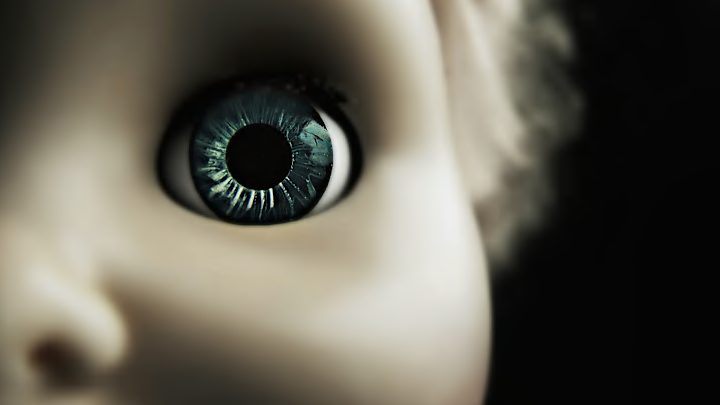There’s something unsettling about dolls. Even before Chucky and Annabelle made them part of the Hollywood horror canon, their glassy, unseeing stares and too-symmetrical features, locked in an unshifting perma-pout, were plenty unnerving.
But not all dolls are created equal: Some are kinda creepy, some are hella creepy, and some are haunted. Or at least, they’re said to be.
The Rise of the Haunted Doll Market
There’s a thriving online market for haunted dolls, a relatively recent phenomenon thought to have taken off in the last decade and largely based around Etsy, eBay, and Instagram. A quick online search reveals thousands for sale (along with accessories and dolls intended to be scary, but not purported to be haunted). Most prices hover around $150, though some haunted dolls sell for over $1000.
A typical listing will include a lengthy, detailed backstory both about how the doll was acquired—often ending up with the seller after changing hands multiple times after spooking owner after owner—and what has supposedly been gleaned about the spirits inhabiting them. Demands the spirit has made, things known to have angered it, and details about both its former life and what it understands about its current existence inhabiting a doll all make for a pretty compelling read, especially alongside a disconcerting glassy stare complete with disturbing cracks.
Certain types of dolls are more popular than others, such as antique models, Wanda the Walking Doll, and Raggedy Ann. (The latter was the type of allegedly demonically possessed doll the “real” Annabelle—made famous by paranormal investigators Ed and Lorraine Warren—was).
Given how scary even non-haunted dolls can be, the idea of specifically seeking out and paying $150 for a potentially possessed toy can seem odd. But according to Kathryn Blowers-McNamara—who runs FugitiveKatCreations, which sells vintage and upcycled items but specializes in antique and haunted dolls—people seek them out for various reasons. Some buyers are looking for the fun of ghost-hunting, while others have more emotional motivations.
“I get a lot of customers who have lost someone and are trying to figure out how to communicate with them,” she told Mental Floss in an email in 2021. “I get a lot of mothers who have lost a child.”
How to Tell If a Doll Is Haunted

Declaring an item haunted is not as simple as just whacking the listing up and waiting for a buyer. “Evaluations are a long process,” Blowers-McNamara said. “It takes months sometimes, with a group of us all comparing notes. We start with the vibe, the energy, our gut feeling. If we sense something there, we pull out the tools.” Said tools include electromagnetic frequency readers, dowsing rods, and a pendulum. The pendulum is often used to try to communicate with spirits. The user holds it out and asks questions, then interprets changes in how it swings as answers.
The doll is then placed in a soundproof box, where recordings are made and scoured for electric voice phenomena, or EVP. These are sounds found on recordings with no explanation behind them. To look for them, people often make recordings of extended periods of what should be silence. They then filter the recording’s sounds, words, or fragments of speech.
“After about a week of EVP recordings, we all spend time with the doll, sometimes up to a month each,” Blowers-McNamara said. “We use meditational telepathy, ESP, lucid dreaming techniques—every method we have as individuals to try to reach the spirit. And, finally, we use a Ouija.”
Blowers-McNamara only sells a doll as haunted if the notes she and her group make all line up with any information they get from the Ouija—otherwise it’s just sold as a vintage doll with “possibly haunted” included in the description.
How to Buy or Sell a Haunted Doll
Selling an item and describing it as haunted brings obvious issues with it. You can’t advertise what you can’t prove, and haunting is yet to be observed under laboratory conditions—let alone approved by any advertising standard authorities. Some platforms, like eBay, have specific rules banning the trade of human souls. Their argument is fairly watertight: If the soul doesn’t exist, then the sale is fraudulent; if it does exist, then the sale is forbidden under rules concerning the sale of human remains.
Sellers of haunted dolls have found a way around this by including a disclaimer that lends the whole thing a certain ambiguity. They insist that all items presented as haunted are done so for entertainment purposes only.
However entertaining one feels owning a haunted doll might be, Blowers-McNamara insists on not taking the ownership of such an item lightly. “Before you start collecting haunted items, please learn how to spiritually protect yourself and your house,” she warned. “If you have kids in the house, do not bring in spirits to the home.” If buying it solely for the novelty, there are inert antiques available. Cheaper and free of malevolent spirits? Bargain.
This story originally ran in 2021; it has been updated for 2022.
